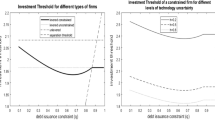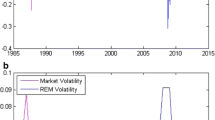Abstract
We address the issue of modeling and quantifying the asset substitution problem in a setting where equityholders decisions alter both the volatility and the return of the firm cash flows. Our results contrast with those obtained in models where the agency problem is reduced to a pure risk-shifting problem. We find larger agency costs and lower optimal leverages. We identify the bankruptcy trigger written in debt indenture, which maximizes ex-ante firm value, given that equityholders will ex-post be able to risk-shift. Our model highlights the tradeoff between ex-post inefficient behavior of equityholders and inefficient covenant restrictions.
Similar content being viewed by others
References
Anderson R., Sundaresan S. (1996) Design and valuation of debt contracts. Rev. Financ. Stud. 9, 37–68
Bliss R. (2001) Market discipline and subordinated debt: a review of some salient issues, Federal Reserve Bank of Chicago. Econ. Perspect. 25, 24–45
Childs P.D., Mauer D.C., Ott S.H. (2005) Interactions of corporate financing and investment decisions: the effects of agency conflicts. J. Financ. Econ. 76, 667–690
Décamps J.P., Faure-Grimaud A. (2002) Excessive continuation and dynamic agency costs of debt. Eur. Econ. Rev. 46, 1623–1644
Ericsson J. (2000) Asset substitution, debt pricing, optimal leverage and maturity. Finance 21, 39–70
Fan H., Sundaresan S. (2000) Debt valuation, renegotiation, and optimal dividend policy. Rev. Financ. Stud. 13, 1057–1099
Goldstein R., Ju N., Leland H. (2001) An EBIT based dodel of dynamic capital structure. J. Bus. 74, 483–512
Graham J. (2000) How big are the tax benefits of debt?. J. Finance 55, 1901–1941
Henessy C.A., Tserlukevich Y. (2004) Dynamic hedging incentives, debt and warrants. Haas School of Business, Berkeley
Jensen M., Meckling W. (1976) Theory of the firm: managerial behavior, agency costs and ownership structure. J. Financ. Econ. 3, 305–360
Ju, N., Ou-Yang, H. Asset substitution and underinvestment: a dynamic view. Fuqua School of Business, Duke University (2005)
Kim I.J., Ramaswamy K., Sundaresan S. (1993) Does default risk in coupons affect the valuation of corporate bonds?: a contingent claims model. Financ. Manage. 22, 117–131
Leland H. (1994) Corporate debt value, bond covenants, and optimal capital structure. J. Finance 49, 1213–1252
Leland H. (1998) Agency costs, risk management, and capital structure. J. Finance 53, 1213–1243
Leland H., Skarabot J. (2004) On purely financial synergies and the optimal scope of the firm: implications for mergers, spin-offs, and structured finance. Haas School of Business. University of California, Berkeley
Mauer D.C., Sarkar S. (2005) Real options, agency conflicts, and optimal capital structure. J. Bank. Finance 29, 1405–1428
Mauer D.C., Triantis A.J. (1994) Interactions of corporate financing and investment decisions: a dynamic framework. J. Finance 49, 1253–1277
Mello A.S., Parsons J.E. (1992) Measuring the agency costs of debt. J. Finance 47, 1887–1904
Oksendal B. (2003) Stochastic differential equations. Springer, Berlin Heidelberg New York
Parrino R., Weisbach M.S. (1999) Measuring Investment distorsion arising from stockholder–bondholder conflicts. J. Financ. Econ. 53, 3–42
Author information
Authors and Affiliations
Corresponding author
Rights and permissions
About this article
Cite this article
Décamps, JP., Djembissi, B. Switching to a poor business activity: optimal capital structure, agency costs and covenant rules. Annals of Finance 3, 389–409 (2007). https://doi.org/10.1007/s10436-006-0049-8
Received:
Accepted:
Published:
Issue Date:
DOI: https://doi.org/10.1007/s10436-006-0049-8




